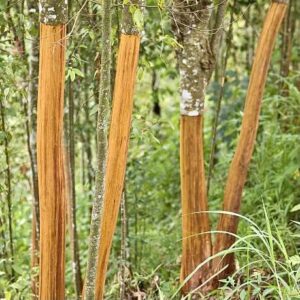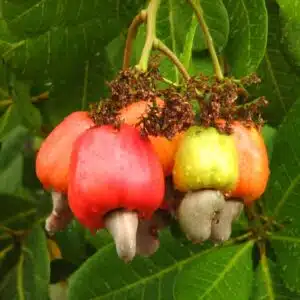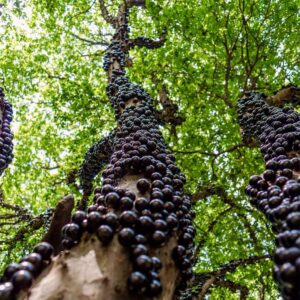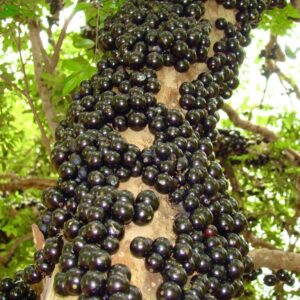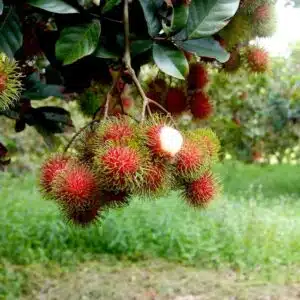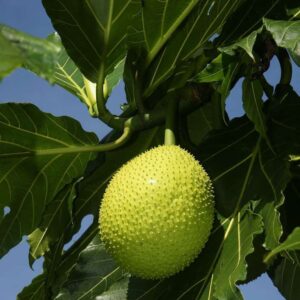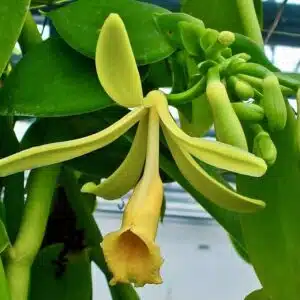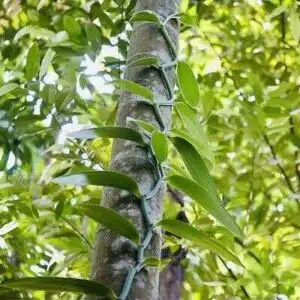Sugar Apple Live Fruit Tree
Sugar Apple, scientifically known as **Annona squamosa**, is a tropical fruit tree native to the Americas, particularly the Caribbean and Central America. It is also known by other names such as sweetsop, custard apple, or anon. This small tree is highly prized for its sweet, creamy, and aromatic fruit, which is popular in many tropical regions around the world.
Cashew nut / pajuil ( Anacardium occidentale ) tropical fruit tree 12”-18” big
The cashew apple is a fleshy, edible fruit with a sweet and tangy flavor. However, it is the cashew nut that grows outside the fruit that is most sought after.
Interesting Fact: The cashew nut is not technically a nut but a seed. It is classified as a seed because it grows outside the fruit instead of within it. Additionally, cashews are not only enjoyed for their taste but also for their versatility in vegan and plant-based recipes. Cashews can be soaked and blended to create creamy dairy alternatives like cashew milk or used as a base for dairy-free cheeses and desserts.
cashew nuts are not only delicious but also offer a wide range of health benefits. With their creamy texture, rich flavor, and versatility in cooking, cashew nuts are a popular choice for both culinary and nutritional purposes. Whether enjoyed as a snack, used in cooking, or incorporated into various dishes, cashew nuts are a delightful addition to any diet. When you purchase a fruit tree from us, rest assured that we prioritize swift and efficient delivery. Following the receipt of your payment, we dispatch your tree the very next day through USPS, ensuring a quick transition from our care to yours. Our fruit trees are not only certified by the USDA, guaranteeing their quality and adherence to stringent agricultural standards, but they also come with a 30-day guarantee. Should you encounter any issues within this period, please don't hesitate to contact us at the number provided above. For a faster resolution, we recommend sending pictures or explaining the situation with your order number. This allows us to understand the issue fully and take the necessary steps to make things right for you.Jaboticaba (Plinia cauliflora) tropical fruit tree 12″-24″
Experience the Magic of Jaboticaba Trees: Where Fruit Grows on the Trunk
Prepare to be enchanted by the allure of the Jaboticaba tree, available for online sale! This extraordinary tropical fruit tree, scientifically known as Plinia cauliflora, is a marvel of nature that will transform your garden into a botanical wonderland. With its unique growth habit, delicious fruit, and cultural significance, the Jaboticaba tree is a must-have for any gardening enthusiast.
Grafted Rambután (Nephelium lappaceum) exotic fruit big live tree 24”-36”
Grafted Rambutan (Nephelium lappaceum): Elevate Your Garden with Exquisite Fruit
Imagine having a stunning rambutan tree in your garden, its lush green canopy adorned with clusters of unique, hairy fruits. Each fruit, when peeled, reveals a sweet, juicy, and aromatic flesh that transports you to a tropical paradise with every bite. Now, picture this tree as a grafted rambutan, combining the beauty and productivity of the rambutan species with the precision of grafting techniques. In this online sale, we introduce you to the world of grafted rambutan trees, from planting and care to their remarkable characteristics and culinary uses.
Grafted Mango Tropical live tree Kent 3’-4’ tall
Grafted Mango 'Kent': A Taste of Tropical Excellence
Mango 'Kent' is one of the most beloved and esteemed mango varieties globally, known for its exceptional taste, vibrant color, and versatility in culinary applications. When grafted, the 'Kent' mango tree combines the desirable qualities of the 'Kent' variety with the benefits of grafting, ensuring a consistent and high-quality fruit production. In this guide, we'll explore the 'Kent' mango, its characteristics, care requirements, and why grafting is an excellent choice for mango enthusiasts.
**Interesting Fact about Grafted Mango 'Kent'**:
The 'Kent' mango variety, including its grafted counterparts, owes its name to a place far from its tropical origins. 'Kent' mangoes were named after Kent, a county in England, where the variety was first propagated in the early 20th century. This English connection may seem surprising for a tropical fruit, but it highlights the global reach and appeal of mangoes. The 'Kent' mango, with its sweet and exotic flavors, quickly gained popularity worldwide, becoming a favorite not only in its native regions but also in countries with significantly different climates, such as England. This fact underscores the universal allure of the 'Kent' mango and its ability to delight taste buds across the globe.
20 Breadfruit seeds (Artocarpus camansi )
Are you looking for a unique and nutritious addition to your garden or farm? Look no further than the breadfruit tree! Not only does this tree produce a delicious and versatile fruit, but it is also packed with essential vitamins and minerals. And the best part? You can grow your own breadfruit tree from seeds!
Breadfruit trees, also known as Artocarpus altilis, are native to the South Pacific but are now grown throughout the tropics. The trees can grow up to 20 meters tall and have large, glossy leaves that provide ample shade. The fruit of the breadfruit tree is round or oblong and can weigh up to 5 kg. It has a starchy, potato-like texture and a mild, nutty flavor that is perfect for use in a variety of dishes.
Miracle tree / moringa (Moringa oleifera) live plant 3’-4’ tall
Moringa tree, also known as the "Miracle Tree," is a fast-growing, deciduous tree that is native to India, but is now widely grown in tropical and subtropical regions around the world. It can grow up to 10 meters tall, but is often pruned to a more manageable size for gardens and farms.
Moringa tree is prized for its highly nutritious leaves, which are packed with vitamins, minerals, and antioxidants. The leaves can be eaten fresh, cooked, or dried and powdered, and are commonly used in traditional medicine to treat a variety of ailments. The seeds of the tree are also edible, and can be pressed for oil or eaten fresh.
The leaves of the Moringa tree are rich in vitamins A, C, and E, as well as calcium, potassium, and iron. They also contain high levels of antioxidants, which help to protect the body from damage caused by free radicals. This makes Moringa tree a popular superfood and a valuable addition to any diet.
To care for your Moringa tree, it is important to plant it in well-draining soil with plenty of organic matter. The tree prefers full sun, but can tolerate partial shade. Water the tree regularly, especially during dry periods, but be careful not to overwater, as this can lead to root rot. Fertilize the tree every few months with a balanced fertilizer to promote healthy growth.
Moringa tree is also easy to propagate. You can grow it from seeds or cuttings. To plant Moringa seeds, soak them in water for 24 hours before planting in well-draining soil. Keep the soil moist until the seedlings emerge. To plant cuttings, simply take a stem cutting and plant it in moist soil. Keep the soil moist and the cutting will root and grow.
In addition to its nutritional and medicinal benefits, Moringa tree is also an environmentally friendly plant. It is drought-resistant, making it a valuable crop in areas with limited water resources. It also has a deep root system, which helps to prevent soil erosion and improve soil fertility.
In conclusion, Moringa tree is a valuable and versatile plant that offers a range of health benefits, is easy to care for, and is environmentally friendly. Whether you are looking to add a new crop to your farm, or simply want to grow a nutritious and beautiful tree in your backyard, Moringa tree is an excellent choice.
Algarroba / Carob (Ceratonia siliqua) Live Tree 12”-24”
Ceratonia siliqua, commonly known as the carob tree, is a small to medium-sized evergreen tree that is native to the Mediterranean region. The tree produces large, dark brown pods that contain a sweet, edible pulp. The pods are often used as a chocolate substitute in baking and confectionery. In this description, we will discuss how to plant and care for a carob tree, and some of the benefits it can provide.
An interesting fact about carob trees is that they have been cultivated for over 4,000 years, and were known to the ancient Greeks and Romans. The pods of the carob tree were used as a form of weight measurement, and were known as "carats," which is the origin of the term used to measure the weight of gemstones. Carob trees were also a symbol of fertility and abundance in ancient cultures, and were often used in religious ceremonies and rituals. Today, carob is used as a healthy and natural substitute for chocolate, and is popular with those who have allergies or sensitivities to traditional chocolate. Carob pods are also used as a natural sweetener, and contain no caffeine or theobromine, making them a safe and healthy alternative to coffee and tea.
Vainilla (Vanilla planifolia) floral fragrance living plant
The Vanilla Plant, scientifically known as Vanilla planifolia, is a botanical gem that captivates with its exotic aroma and rich flavor. This plant, treasured for its role in producing one of the world's most beloved spices, invites you to delve into the fascinating journey of vanilla cultivation and the allure of its sweet and aromatic beans.


